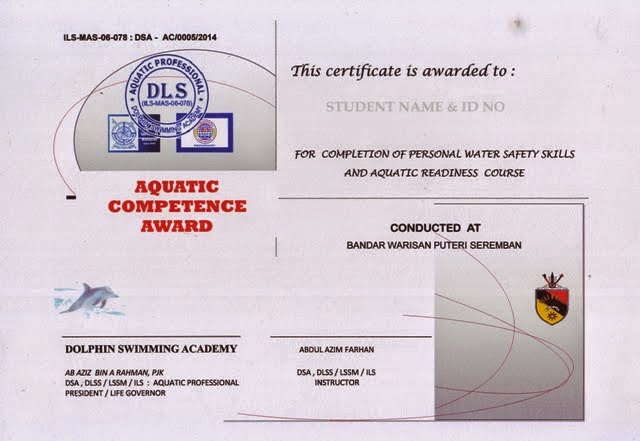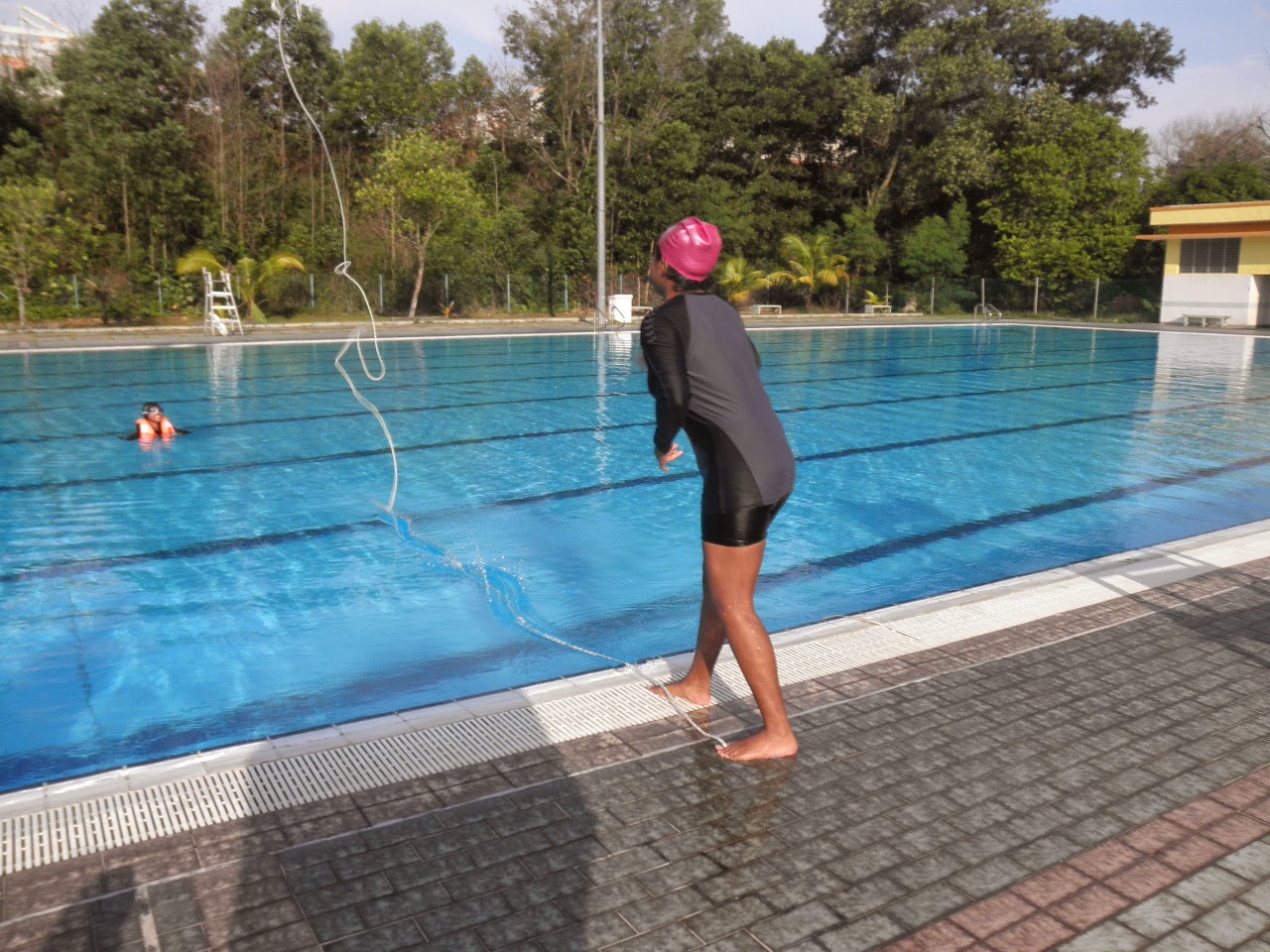DOLPHIN LIFE SAVING ACADEMY

Thursday, October 8, 2015
Sunday, May 11, 2014
AQUATIC COMPETENCE PROGRAM
We have been
operating for the past 20 years. Our coaching experiences contribute to Quality
Coaching. We stop our operation at Seremban 2 on Mar 2013 and continue
providing Swimming Courses at our Private Swimming Pool.
e mail: academydsa@gmail.com Contact: 013-6673489
e mail: academydsa@gmail.com Contact: 013-6673489
Club Member
of Life Saving Society Malaysia.
Promoting New Approach In Teaching Swimming - "Fast track learning"
Monday, April 21, 2014
LIFEGUARD CERTIFICATION
DLS LIFEGUARD CERTIFICATION
Module Combination of Bronze
Medallion & Pool Lifeguard training
Compliance To: Certifications guidelines INTERNATIONAL LIFE SAVING FEDERATION (ILS) -
World Water Safety : Certificate demonstrates successful completion of approved knowledge and skill objectives.
Compliance To: Certifications guidelines INTERNATIONAL LIFE SAVING FEDERATION (ILS) -
World Water Safety : Certificate demonstrates successful completion of approved knowledge and skill objectives.
DLS Course develops the level of knowledge, judgment and techniques required to carry out safe water rescues AND
Train
and qualify candidates with the necessary skills and knowledge to supervise
swimming pool users.
Prerequisites:
- Aquatic competence Award (Senior Swim and Survive)
- The candidate must be 16 years of age
Resuscitation
Course (CPR)
Perform CPR
award is valid for one year. This course includes up-to-date methods of
performing CPR. Techniques for adults, children and infants are included.
Pre-requisite:
Nil
Course
duration: 2 hours
DLS LIFESAVER CERTIFICATION
A part of
the Lifesaver is the fitness Test which involves a 800m swim in 14 minutes continuous. Prior to attending the
course candidates should as a guide be able to swim 200 metres freestyle
continuously within 6 minutes and practice the other three strokes. Open Water Rescue Skills Training.
Prerequisites:
Hold and be
proficient in the following awards
1. Lifeguard
Certification (DLS)/Bronze Medallion(LSSM)
2. Resuscitation
Course (CPR)
Friday, April 11, 2014
Wednesday, April 2, 2014
AWARD
Everyone can be a lifesaver, this includes
you.
Drowning
is one of the leading causes of preventable death.Provide instruction and training to aid in the acquisition of knowledge, skills, or competencies.
World Water Safety
INTERNATIONAL LIFE
SAVING FEDERATION
Fitness
Testing for Lifeguards
NOTE: This statement is intended for
those lifesavers, acting in a professional or volunteer capacity, who are
trained in the techniques of water rescue and resuscitation and who assume a
duty to safeguard members of the public at aquatic sites. They may be called
lifeguards, lifesavers or both. This statement is not directed at members of
the public trained in water safety and rescue techniques, but without a duty to
respond, who may also be known, in some areas of the world, as lifesavers.
The standards outlined in this
position statement are the minimum that ILS recommends. ILS encourages
organisations to exceed these recommended minimum standards where local
conditions and/or expectations of lifeguards are warranted.
Background
Experts in the field of lifeguard
training and rescue believe that lifeguards need to be able to demonstrate a
reasonable level of fitness. It is presumed that lifeguards would have sound
swimming and water rescue skills.
The available English language
studies in the aquatic setting were reviewed. The data is cohort studies of
lifeguard pre-employment assessment outcomes. Level of evidence from the
research is low and not directly related to the question addressed in this
review. There are no direct outcome data for lifeguards responding to victims.
The level of evidence in literature is low and most frequently expert opinion.
The swimming data was extrapolated from swimming pool environments. The beach
data did not involve swimming.
Lifeguard training manuals from many
national lifeguard training programs were reviewed. Many had minimum swimming
performance recommendations, based on consensus expert opinion. These
recommendations have been in place for many years and in some cases many
decades. This history of application of recommendations to the issue at hand is
the strongest evidence available.
Many national lifeguard training
organisations have been using similar fitness testing standards for many years.
There is a lack of evidence of success and a lack of evidence of risk or injury
to victims or rescuers. Retrospective and prospective research is recommended
to provide further data on this issue. The recommendations that follow are
based on consensus expert opinion of the ILS Rescue Committee.
Statement
The International Life Saving Federation
recommends that prospective research is recommended to provide data on this
issue.
The minimum standards of fitness
testing for lifeguards are recommended as follows, until there is data to
confirm, refute or modify these consensus expert opinion recommendations.
- A swimming test is an appropriate way of demonstrating fitness in a lifeguard.
- Fitness tests should be conducted with the bare minimum of equipment (i.e. no fins or flotation devices), and can be conducted in any suitable body of water over a measured distance. If the swim test is being conducted in a pool, that pool should be a minimum of 25 meters in length.
- Training organisations should ensure candidates are safe in the environment in which they will be participating in their lifeguard training. At all times the safety of lifeguards undertaking a fitness test is paramount. Organisations conducting fitness tests for lifeguards should ensure their safety through the provision of adequate water coverage including the use of surveillance and rescue craft where appropriate.
- Assess the level of swimming ability in a safe environment, prior to training in an open water environment. For clarification, ILS has not recommended a minimum entry (pre-test) assessment. Each organisation undertaking training should have an entry level pre-test based on their particular circumstances. In the absence of a pre-test being undertaken, appropriate risk mitigant strategies need to be put in place.
- Appropriate skill training in the environment in which the lifeguard will be operating is also recommended including how to enter the water, wading techniques, surf swimming skills, use of rips, etc. Research by Tipton et al concluded that pool swim times and other land-based tests do not strongly predict surf swimming performance. Therefore, it is recommended that tests for surf lifeguards be conducted in the surf environment.
- Assessing fitness through a minimum swim fitness standard
- The ILS recommended minimum swimming requirement for beach and open water lifeguard award is: 400 metres in 8 minutes.
- The ILS recommended minimum swimming requirement for pool lifeguard award is: 400 metres continuous un-timed and a timed test of 50 meters in 50 seconds.
- Operational requirement: Organisations should assess operational requirements and where necessary develop additional specific standards to meet that operational requirement. This may include a timed run, lifting (weight) standard, timed utilisation of equipment specific to that operation/location or a combination of the above (i.e. a timed run/swim/run).
Approved
ILS Lifesaving Commission 2 November
2007
Subscribe to:
Posts (Atom)






























